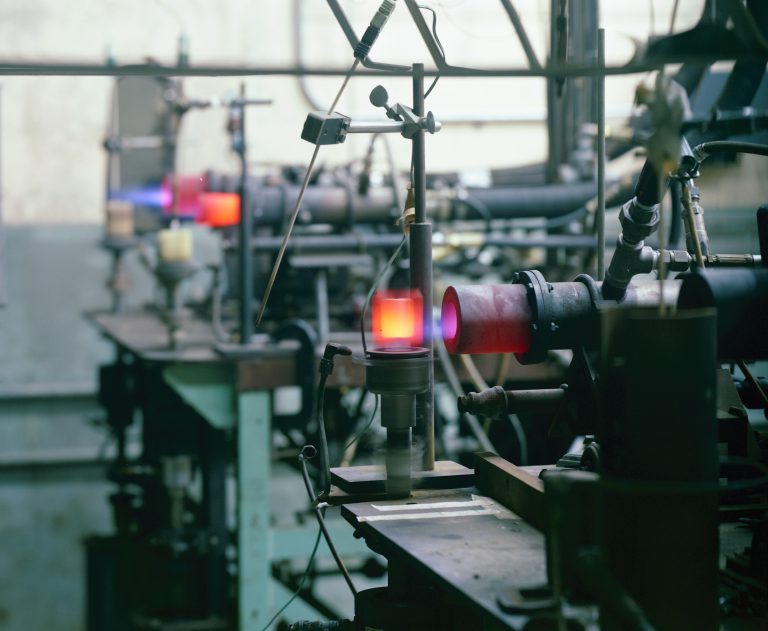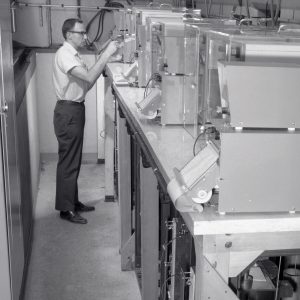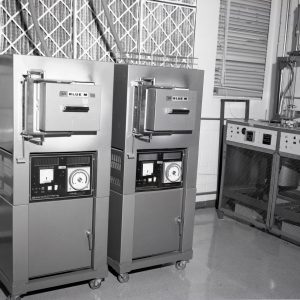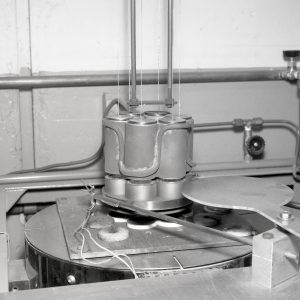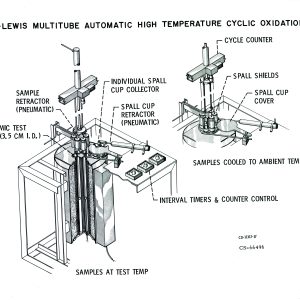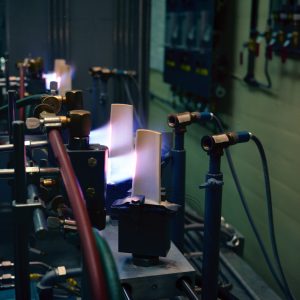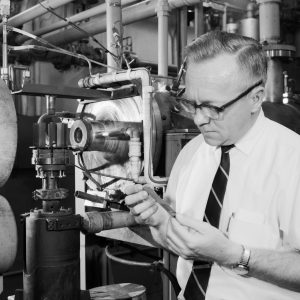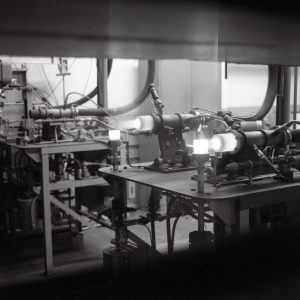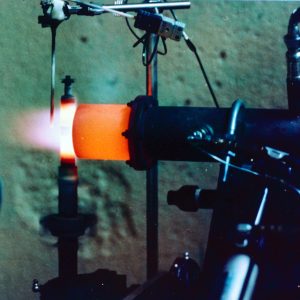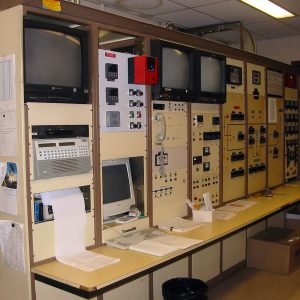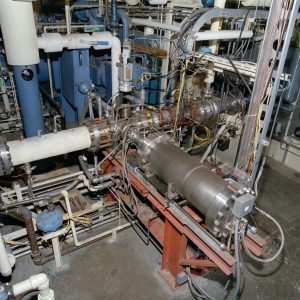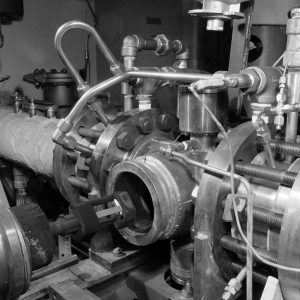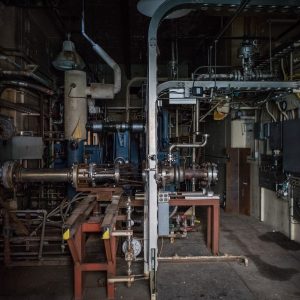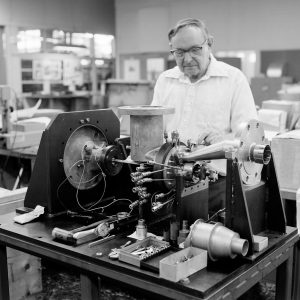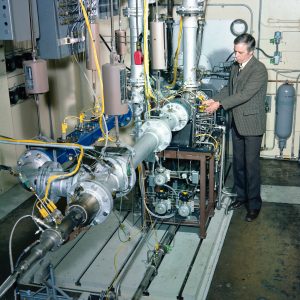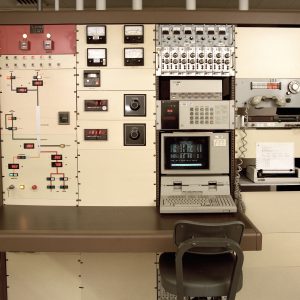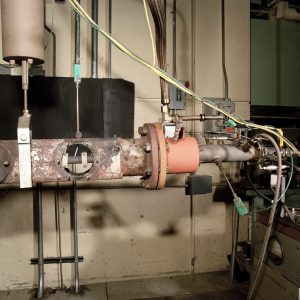Materials Research
A variety of materials test rigs installed in the Special Projects Laboratory (SPL) provided researchers with expedient and economical methods to study oxidation and fatigue in various alloys, ceramics, and coatings.
Overview
The need to continually improve the performance of turbine blades was an important aspect of NASA Lewis Research Center’s renewed interest in aeronautics in the early 1970s. Engineers continually sought to develop components capable of withstanding higher temperatures, particularly important for turbine blades, which are located in the hottest part of the engine. There are three basic methods to achieve this: new high temperature materials, cooling systems and ceramic coatings. The performance of conventional alloys reached their limits during this period and directionally solidified alloys were cost prohibitive. Cooling systems at the time were complex, expensive and often hindered engine performance. Engineers increasingly focused on the development of thermal barrier coatings (TBCs) to protect turbine blades.
In 1968, the center added the Coatings Section to the Materials and Stresses Division to study different nickel- and zirconia-based coatings for turbine blades. The coatings provide a protective barrier between the hot engine gases and the cool metal turbine blades and other components. They are applied using a plasma spray deposition developed at Lewis in the 1960s. These materials tended to suffer from oxidation and compressive thermal stress. This was exacerbated by the cyclic temperature variations that engines endured during normal operation. Another concern was the corrosive conditions found in the atmosphere near oceans, stemming from the mixture of combustion byproducts with salt in the air.
In the late 1960s and early 1970s, a variety of material test rigs were installed in the Special Projects Laboratory (SPL). This equipment provided researchers with expedient and economical methods to study oxidation and fatigue in various alloys, ceramics and coatings. These facilities were significantly upgraded over the next 30 years to support both the center’s basic research and large technology advancement programs.
Documents
- Two-Layer Thermal Barrier Coating Furnace and Burner Rig Tests (1976)
- Response of Thermal Barrier Coating to Sodium Combustion Gases (1979)
- History of Thermal Barrier Coatings for Gas Turbine Engines (2009)
- Revisiting the Birth of 7YSZ Thermal Barrier Coatings: Steve Stecura (2017)
Cyclic Oxidation
Repeated temperature fluctuations impose some of the greatest stress on materials. This is particularly relevant to aircraft engines, which typically operate for only a few hours at a time. The high temperatures of normal operation cause the metal components to expand, which creates a beneficial oxide scale on the surface. During post-flight cooling, however, contraction of the metal causes the scale to crack or buckle. This degradation becomes an issue over the many thermal cycles experienced during the lifetime of an engine. Lewis researchers developed a two-tiered approach that employed furnaces and burner rigs in the SPL to study this phenomena.
Lewis researchers began studying the effects of recurrent heating in the late 1960s by testing alloy samples for periods of up to 20 hours in oxidation furnaces in the SPL. The furnaces provided a simple method for subjecting a large number of specimens to controlled thermal cycles for a given duration. The initial furnace designs were labor-intensive, however, so Lewis developed the automated Cyclic Oxidation Facility in SPL. This facility included eight automatically cycling furnaces that subject six samples simultaneously at temperatures of up to 1,600 °C for 100 hours at a time. Lewis researchers primarily used the furnaces to study superalloys and alloys but also tested steels, TBCs and ceramic composites. Researchers used data from the furnace testing to construct a database containing the performance statistics of thousands of commercial and experimental alloys.
Documents
- Furnace Testing of Aluminide-Coated Cobalt Super-Alloy WI-52 (1970)
- Cyclic Furnace Oxidation of Clad WI-52 Systems (1972)
- Cyclic Oxidation Testing and Modelling: A NASA Lewis Perspective (2000)
- Cyclic Oxidation Data Base for Materials Tested at NASA Glenn (2003)
Images
Burner Rigs
Researchers frequently used the furnaces in conjunction with high-speed burners. These small open-jet rigs provide the simplest and least expensive method for simulating hot engine conditions. There were three Mach 1 and four Mach .03 burners in the SPL.
Researchers sought to compare a material’s performance during slow heating in furnaces with rapid burner heating in an attempt to develop an inexpensive, standardized method of predicting oxidation for coated superalloys. The high-velocity gas flow in engines increases evaporative losses in some materials and the thermal cycling contributes to oxidation of cracked or spalled materials. Testing on the burner rigs frequently resulted in cracks on the blades’ leading edge. Researchers also used the rigs to study oxidation caused by cyclic heating and to test the performance of coatings designed to prevent oxidation.
Mach 1 burner rig testing of alloys with and without coatings in the late 1960s demonstrated the increased durability provided by aluminide coatings. In the mid-1970s, researchers began studying a plasma-sprayed zirconia coating for nickel alloys already coated with aluminide. Cyclic furnace and Mach .03 burner tests revealed the two-layer coating withstood erosion and cracking. Lewis demonstrated the dual coating’s potential to lower blade metal temperatures by testing it on a Pratt & Whitney J75 engine.
Lewis researchers made significant advances in oxidation testing, modeling, and analysis of scale. In the early 1990s, Lewis established the cyclic oxidation spalling program (COSP) to create a model that defines the scale growth and spallation processes for alloys.
Documents
- Oxidation and Thermal Fatigue Cracking of Nickel- and Cobalt-Base Alloys (1969)
- Burner Rig Cyclic Oxidation Evaluation (1973)
- High Velocity Oxidation and Hot Corrosion Testing of OSD Nickel-Base Alloys (1975)
- Two-layer Thermal Barrier Coating–Furnace and Burner Rig Tests (1976)
- High Velocity Burner Rig Oxidation and Thermal Fatigue of SiC Base Ceramics (1978)
Images
High Pressure Burner Rig
In the 1980s, Lewis installed the High Pressure Burner Rig (HPBR) in Cell 6 of the SPL to perform hot corrosion testing. The rig operates similarly to the smaller burner rigs, but it includes a pressurized test section to further simulate actual conditions within an engine. Researchers used the HPBR sporadically during the 1980s to test alloy samples in exhaust flow with lean-fuel mixtures. In the 1990s, however, the HPBR became an important tool supporting the High Speed Research (HSR) program, which sought to develop technology for future supersonic transport aircraft. In 1992, Lewis and industry partners initiated the Enabling Propulsion Program to develop high-temperature and lightweight composite materials for the new low-emission combustors, noise-suppressing nozzles and other components.
General Electric and Pratt & Whitney sought to use silicon-based ceramic matrix composites for their combustor designs. It was not known how these materials, which generally produce an oxidation-resistant scale, would perform in fuel-rich combustion chambers. Lewis engineers redesigned the HPBR to create these conditions and scrub the exhaust. HPBR tests of the silicon composites revealed for the first time that high-pressure water vapor indicated detrimental loss of protective oxide scales and recession of the material. The researchers created an enduring method for defining the recession losses. This led to the creation of life prediction tools and eventual development of a three-layer coating system for silicon composite components. The HPBR was essential to understanding oxidation in silicon carbide.
Documents
- Enabling Propulsion Materials for High-Speed Civil Transport (1992)
- Lewis’ Lean-, Rich-Burn Materials Test Burner Rig (1994)
- High Pressure Burner Rig Facility and Materials Test Capabilities (1999)
- SiC and Si3N4 Recession Due to Volatility Under Combustor Conditions (1999)
- SiC/SiC Leading Edge Turbine Airfoil Test (1999)
Images
Laser
The burner rigs were an efficient materials testing tool, but they could not replicate the high-heat flux or uneven heating that occurred in actual engines. To better simulate these conditions, Lewis researchers designed a laser rig in the 1990s that replicated the steady-state heat flux found in engines and included backside cooling to create the temperature gradients. This provided a more realistic method of testing TBCs. The rig passed a 3-kW carbon dioxide laser through a lens onto a test article rotating at 300 rpm. An aluminum plate with a portal was affixed to the sample and backside cooling air maintained the desired temperature gradient. This was the first facility that could provide thermal gradient testing. Another improved version of the rig was later installed in another SPL test cell, and the system has been implemented at other institutions.
Improved coatings allowed higher engine temperatures, which then stressed the durability of the coatings, so constant testing and improvements were needed to develop predictive tools. Although the HSR program was ultimately canceled, the Lewis materials work continued under the Ultra Efficient Engine Technology (UEET) program.
Documents
- Conductivity of Thermal Barrier Coatings under High Heat Flux (1999)
- Development of Environmental Barrier Coatings Using High Heat-Flux (2003)
- Thermal Conductivity by a Steady-state Laser Heat-Flux Approach (2004)
Hot Corrosion
As the performance of aircraft engines improves, the associated temperatures and stresses endured by their components, particularly turbines, also increases. Turbine durability affects maintenance and fuel costs. The high temperatures of aircraft engines cause sodium [chloride] contaminants, present in the atmosphere near oceans, to react with sulfur impurities from the fuel. The produces sodium sulfate, which adheres to engine components and greatly accelerates their oxidation. The destructive phenomenon, referred to as hot corrosion, was discovered in the 1960s, but surprisingly, it did not result in any known engine failures. Early studies revealed that the engine’s high-speed air flow and cyclic operation naturally reduced the levels of corrosion.
Nonetheless, the potential for failure remained in newer engines that would operate at higher temperatures and for longer periods of time. Although researchers made some headway in understanding hot corrosion, they had yet to develop predictive models needed for future engine design. In 1981, Lewis initiated the Turbine Engine Hot Section Technology (HOST) project to develop a method to predict the effects of high temperatures and hot corrosion on TBCs for turbines. Studying hot corrosion on an actual engine is cost-prohibitive and the resulting data may not be transferrable between models. Burner rigs provide an economical and simple way to gather data, but there was disagreement over whether small-scale laboratory tests were useful.
To fill this void, Lewis built a Replaceable Blade Turbine Facility in the early 1980s inside Cell 1 of the SPL. The facility provided a simple, inexpensive and flexible tool for oxidation and corrosion testing. It could subject turbine materials to hot corrosion conditions at temperatures up to 1,830 °F. The rig combusted a jet fuel and salt mixture and directed the highly pressurized flow onto a test stand containing the articles or turbine. The facility could automatically operate for 100 hours. The Replaceable Blade Turbine Facility was used to verify the HOST models. The HOST program eventually yielded three design-capable models.
The Replaceable Blade Turbine Facility in Cell 1 was upgraded in the early 1990s and renamed the Hot Corrosion Test Facility. The facility has been used to test a variety of ceramic- and silicon-based thermal barrier coatings.
Documents
- Hot Salt Stress Corrosion of a Titanium Alloy (1969)
- Hot Corrosion Behavior of Thermal Barrier Coatings (1980)
- Turbine Engine Hot Section Technology (HOST) Workshop (1982)
- Replaceable Blade Turbine and Stationary Specimen Corrosion Testing Facility (1985)
- HOST Life Modeling Summary (1989)
- Hot Corrosion Test Facility at Special Projects Laboratory (1994)

